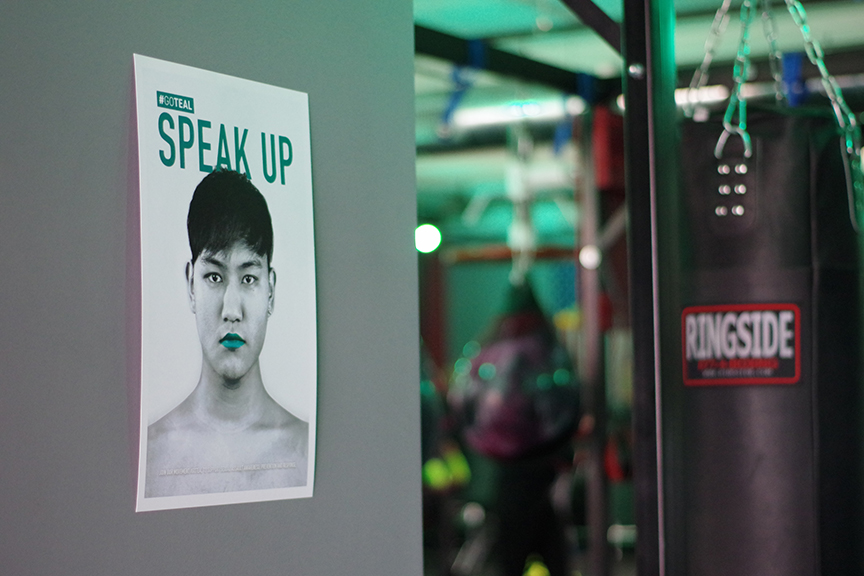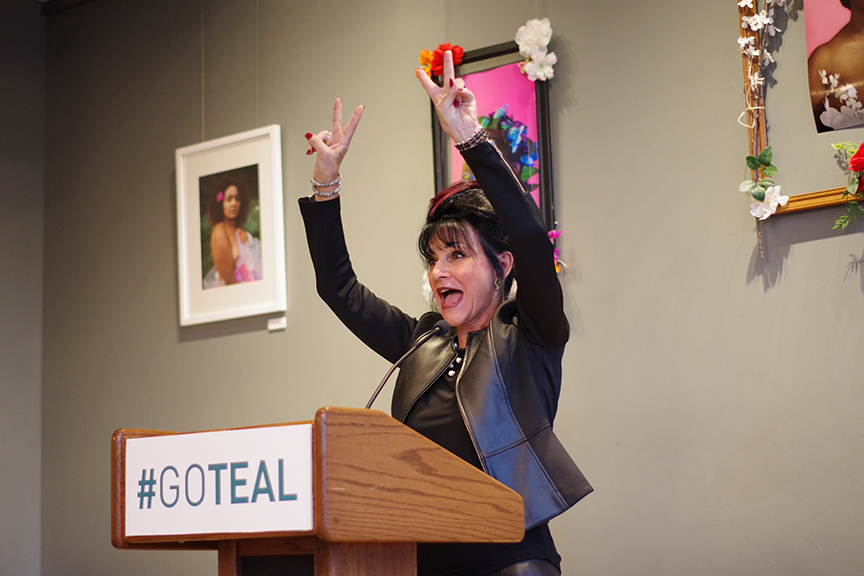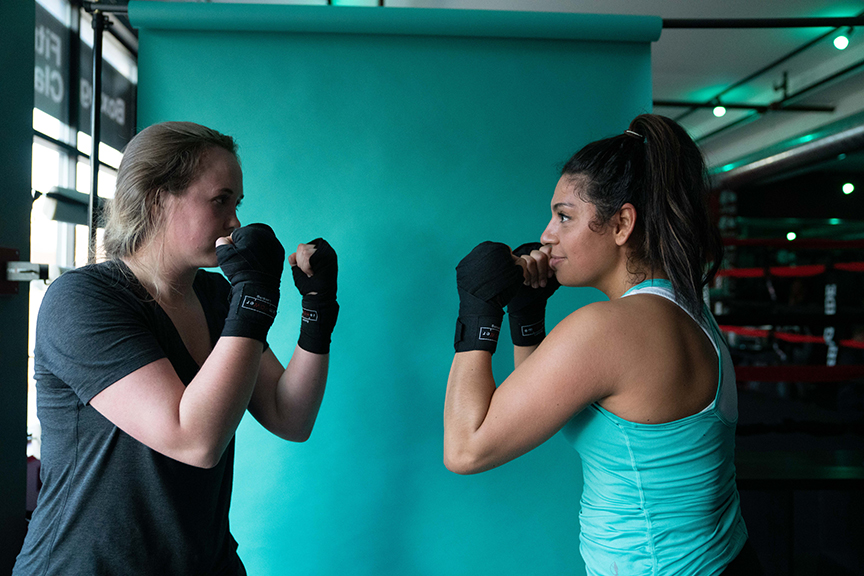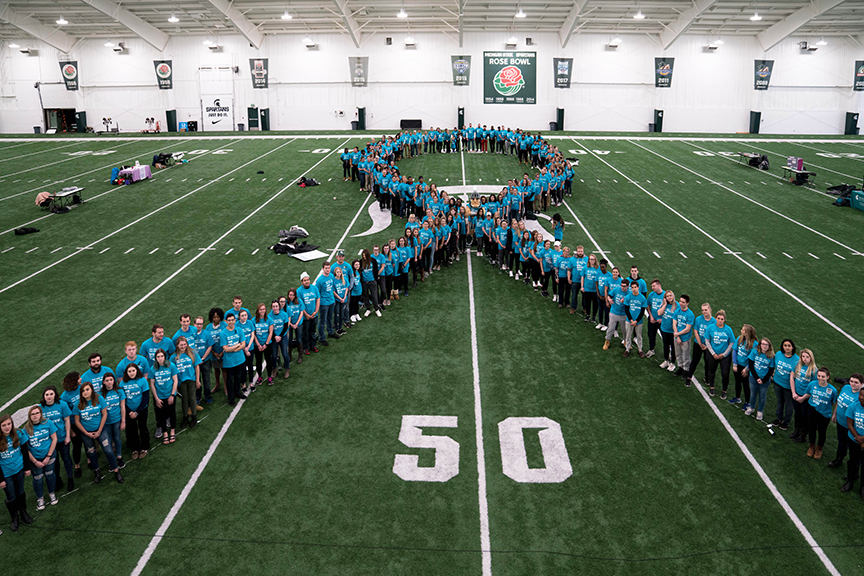Student Created Campaign Becomes a Movement, Supporting Survivors One Year Later
One message is now weaved into the fabric of Michigan State University’s history: #GoTeal.
In early 2018, former doctor Larry Nassar was sentenced to up to 175 years in prison for sexual assault. As the MSU community struggled to grasp the magnitude of his crimes, students in the College of Communications Arts and Sciences created a campaign that sparked a movement.
More than a year later, elements of the #GoTeal campaign can still be found on campus, and its message of activism for sexual assault awareness, prevention and response is still at the forefront of university actions.
‘Rooted Strong and Without Fear’
Young women set out to change the culture at MSU in early 2018. Working together in a voluntary strategic challenge, they conceptualized #GoTeal as a hashtag together with a video of an orchid wilting, shown in reverse, as a metaphor for the journey of survivors of sexual assault.
Spartans Amanda McCafferty, Larraine Fu, Carlie Wirebaugh, Tianyi Xie and Yi Rong combined creative forces to bring the concept to life.
Hosted by Professor Ross Chowles, the Idea-A-Thon challenge invited students to develop strategic solutions in the Department of Advertising + Public Relations. Chowles witnessed the TV camera crews documenting the crisis on campus, and developed a brief based on the issue.
“It was tragic. Now, MSU is famous, but for the wrong reasons,” said Chowles. “So, that was the brief I gave the students. I said, ‘How do we turn this negative into a positive?’ The brief didn’t say, ‘How do we create student support in the face of a situation where the students distrust the university.’ It didn’t start that way, but that’s where it ended up.”
Students seized the opportunity to use open communication and the power of creative expression, showing campus-wide support for survivors.

Larraine Fu, Carlie Wirebaugh, Tianyi Xie and Yi Rong, who co-created the #GoTeal campaign as international students at MSU, show their support for survivors with Sparty.
“I think what #GoTeal was, was really students saying, ‘We’re supporting each other.’ That’s the power, really,” Chowles said.
For Tianyi Xie, this act of support was difficult to put into words. Looking back, she shared empathy for survivors of sexual assault, saying she was honored to be part of the project.
“It’s so difficult in my own country. Your voice is muted,” she said. Hailing from China, Xie photographed survivors for the Speak Up poster series, shining a powerful lens on freedom of expression. “The difference is here, there are no obstacles.”
McCafferty joined the team to write a script for the video, titled “Together, we bloom.” The words described a flower that has been stomped on and wished upon and transformed defeat into the hope of a flower growing back to bloom again.
The creative team led the #GoTeal movement by producing poignant imagery, as well as a Teal Ribbon installation encouraging others to support survivors and help prevent sexual assault. They produced a second video, distributed resources, and designed posters, urging others to Speak Up when they see signs of sexual assault to stop predators in the act.

The award-winning posters designed as part of the #GoTeal movement can be seen on MSU's campus and in the community, encouraging passers-by to become an ally for survivors. Photo by Austin Pabian.
McCafferty said the team worked to share the message where it was needed most – conducting outreach to restaurants, bars, clubs and other venues around East Lansing.
“For one person, #GoTeal could have given them the courage to speak up,” said McCafferty. “If we continue to put ourselves out there, potentially so many sexual assaults could be stopped. That’s what made it a movement.”
While the messages offered support and understanding to survivors, the goal of the movement was to motivate people to action, to encourage everyone to play a role in stopping sexual assault before it happens.
“Our main target audience was bystanders who don’t always know what to say and who need help making that leap from bystander to ally,” said McCafferty. “I’m proud of our team being a voice in all this chaos. I’m saddened that this is a part of our history forever.”
The movement gained momentum, leading to public awareness events in the community and a human Teal Ribbon created by the MSU Community.
Since its inception, #GoTeal has given out more than 2,000 teal ribbons to the community. The creators host events around East Lansing, partnering with organizations to offer talks, resource fairs, self-defense training, confidence building dances and more. They also distribute Speak Up cards with empowering images and resources for victims.
“On one hand, I’m super proud of the movement and the noise we created,” said McCafferty. “It’s heartbreaking in a way, because we had to address this at all.”

Judge Rosemarie Aquilina attended an open mic April 5, 2019, at Strange Matter Coffee in Lansing, to show her ongoing support for survivors of sexual assault and the #GoTeal movement. Photo by Austin Pabian.
The Color That Changed Everything
“#GoTeal was sort of the nucleus of student activism,” said MSU Museum Director Mark Auslander.
Working with survivor support groups like The Army of Survivors and POSSE (Parents of Sister Survivors Engage), the MSU Museum is currently featuring the exhibit: “Finding Our Voice: Sister Survivors Speak.” It will run through March 20, 2020.
Many initiatives sprouted up to support survivors across campus, and they are now being honored in the MSU Museum. Journalism students worked to produce reporting and photography that respected the survivors’ needs and didn’t exploit them in unethical ways. A speaker series was also held at MSU.

Students, survivors and allies participated in an event at emPOWer gym organized in cooperation with #GoTeal on April 5, 2019, showing support for one another and learning self-defense. The event is one of many ongoing efforts to support survivors in the community. Photo by Tianyi Xie.
“What’s wonderful is that it’s also about the power of design, the power of color,” said Auslander. “We all have these enormous defenses against facing up to the most tragic and unpleasant aspects of life, and these students – these advertising, public relations and communications students — really understood that these technologies of persuasion can be used for something more than just selling stuff, but can actually be transformative, and reach and wake up all of us unto our better angels.”
“I was glad to see some productive advocacy coming out of MSU at that time,” said survivor Danielle Moore, a member of the Army of Survivors. “Being a survivor is incredibly isolating, and when you see these groups of people kind of rallying for your cause it makes it less isolating. That makes you feel less alone and that you are more supported. For so long, there was no support.”
The #GoTeal movement led to the creation of a human teal ribbon, with the help of ASMSU, It’s On Us Week, MSU and more organizations. It was first orchestrated in 2018 and recreated during It’s On Us Week on April 5, 2019.
“The human teal ribbon event last year was possibly the most empowering night of my life,” said McCafferty. “We were a sea of teal – MSU students wearing teal, standing in solidarity for survivors saying, ‘We see you. We hear you. We believe you.’”

Led by the co-creators of the #GoTeal movement, MSU students create a human teal ribbon on campus, a lasting ribbon of hope for sister survivors and survivors of sexual assault. File photo.
A Lasting Ribbon of Hope
For students, the best part of producing the #GoTeal campaign and the movement that followed was the ability to make meaningful change. If they wanted more, it’s the possibility that #GoTeal will live on as a lasting ribbon of hope for survivors of sexual assault.
The work of these recent graduates also garnered attention at the regional and national level. #GoTeal received five Gold ADDY Awards in Mid-Michigan, advancing to the national competition at the American Advertising Federation.
“The color, teal, now means so many things to me;” said McCafferty, “It means empowerment, courage, strength, support, solidarity, unity.”
McCafferty said the color was symbolic of the movement for many reasons.
“Coming from a background in communication and art, the color teal is actually a shade of blue and green: blue acts as a calming property and the green is supposed to add its renewal qualities. Artistically speaking, it serves as a revitalizing color,” said McCafferty. “We wanted to spark that energy into the community to Speak Up and Speak Out against sexual assault, so that something like this would never happen again.”
Teal also represents hope, not just for the #GoTeal organizers, but for the university, the community and the world.
“Although we know our movement will never be able to change what happened at Michigan State, we hope it serves as a beacon of light in the darkest of our times and brings comfort to survivors, knowing there's a sea of teal out there who hear them, support them, and believe them,” said McCafferty.
In the future, they’ll be looking for ways to carry on the powerful work they’ve started, whether that means creating a nonprofit organization, creating a new campaign every year or finding students who can carry the teal torch of hope into the future.
What it really means to #GoTeal comes down to an urgent call to activism.
“Don’t just be a bystander. Be an ally,” said McCafferty.
By Melissa Priebe
